Sarah Sundin's Blog, page 177
September 4, 2019
Memories of Glass by Melanie Dobson
 In Nazi-occupied Holland in 1942, Josie van Rees is disturbed as her Jewish friends and neighbors are rounded up – but are the rumors of the dangers facing them true? And what can one young woman do? Her childhood friend Eliese Linden is Jewish, but is protected by her work registering the Jewish people at the Schouwberg Theater in Amsterdam. She despises herself – if only she could find a way to make the children disappear from the Nazi records – and Josie could whisk them into hiding.
In Nazi-occupied Holland in 1942, Josie van Rees is disturbed as her Jewish friends and neighbors are rounded up – but are the rumors of the dangers facing them true? And what can one young woman do? Her childhood friend Eliese Linden is Jewish, but is protected by her work registering the Jewish people at the Schouwberg Theater in Amsterdam. She despises herself – if only she could find a way to make the children disappear from the Nazi records – and Josie could whisk them into hiding.
In modern-day New York, Ava Drake works for her family’s Kingston Foundation, distributing the family’s wealth, earned from helping the Netherlands recover after World War II, to deserving organizations. Ava is sent to Uganda to Landon West’s coffee plantation, where he gives jobs and housing and education to the locals. Ava and Landon are drawn to each other – but when they discover a connection between their families, the unearthing of carefully buried secrets puts Ava in grave danger.
Breathtaking, heartbreaking, and ultimately uplifting. Memories of Glass shows the beauty when people do anything to help others, the ugliness when people do anything to help only themselves, and the destructive power of secrets through the generations. Melanie Dobson’s memorable characters and fine eye for detail bring the danger of the Netherlands under Nazi occupation to life. This novel will stay with you.
August 21, 2019
Love and Other Mistakes, by Jessica Kate
 Natalie Groves couldn’t be having a worse day. Her career dream is long dead, she’s losing her job, and her father has cancer. Then she finds out her ex-fiance, Jeremy Walters, is back in town after having dumped her seven years earlier – with his nine-month-old son.
Natalie Groves couldn’t be having a worse day. Her career dream is long dead, she’s losing her job, and her father has cancer. Then she finds out her ex-fiance, Jeremy Walters, is back in town after having dumped her seven years earlier – with his nine-month-old son.
Jem has returned for his dream job, with hopes of reconciling with his family. But his overbearing father remains as critical as ever. Even cute baby Oliver can’t melt his father’s hard heart. When Jem learns Natalie has lost her job, he asks her to be Olly’s nanny, and Natalie is desperate enough to accept.
Love and Other Mistakes is a sparkling story full of humor and banter. Yet this debut novel is so much more than just cute. Jessica Kate explores the pain caused by family secrets, betrayal, and broken dreams, and shows the difficulty of wrestling with them – and the joys of doing that wrestling. Natalie and Jem are characters with depth – and they have amazing chemistry! I thoroughly enjoyed this story, and I recommend it wholeheartedly!
August 15, 2019
France’s Other D-Day – Photo Tour of Southern France

Sarah Sundin at the Vieux Port in Marseille, France, August 2011 (Photo: Sarah Sundin)
When my family had the opportunity to visit Italy and southern France in 2011, I was doubly delighted. Not only could we tour countries I had always longed to see, but I could conduct research for my Wings of the Nightingale series, which follows three World War II flight nurses in the Mediterranean. The third novel, In Perfect Time, revolves around Operation Dragoon, the Allied invasion of southern France on 15 August 1944, “France’s other D-Day.”
Operation Dragoon

Troops of US 45th Infantry Division land at Ste. Maxime in southern France, 15 Aug 1944 (US Army Center of Military History)

C-47 Skytrains of the 81st Troop Carrier Squadron loaded with paratroopers on their way for the invasion of southern France, 15 Aug 15 1944. (US National Archives)
Operation Dragoon is often forgotten, but it was vital to the war effort. The D-Day landings in Normandy had been successful, but the vast motorized Allied armies needed mountains of supplies, which required good ports. When the US Seventh Army landed along the poorly defended French Riviera, Gen. Alexander Patch’s masterful leadership led to swift victory. By the end of August the crucial ports of Marseille and Toulon were in Allied hands, and within one short month of the landings, the Dragoon forces had linked with the Overlord forces, freeing southern France from Nazi rule.

The house we rented in Puyloubier, France, August 2011 (Photo: Sarah Sundin)
Photo Tour of Southern France
For our week in Provence, my teen daughter dreamed of ordering a baguette at the boulangerie in her high school French from a handsome, beret-wearing young man (dream dashed – the pudgy middle-aged woman behind the counter pretended not to understand one word she said). Her younger brother dreamed of seeing medieval catapults and trebuchets in action (dream fulfilled!). But I dreamed of seeing historical places and the sites included in my novel.

Airfield at Istres, France, August 2011 (Photo: Sarah Sundin)
One of the sites on my list was the airfield at Istres near Marseille, where the Troop Carrier Groups and flight nurses were based in 1944. This was an important base for flying supplies to the front and for returning with the wounded. Since it’s an active military base, I didn’t expect to get close. To our surprise, we were able to drive right onto the base. We kept driving, kept taking pictures, expecting at any minute to be chased down by an armored vehicle. We weren’t. The field looks generic, but I felt the history, even more poignant because the men and women based at Istres were unsung heroes who didn’t receive – or expect – the accolades reserved for men on the front. But I remember their work, their courage, and their sacrifice.

Eglise St.-Laurent in Marseille, France, August 2011 (Photo: Sarah Sundin)
In my novel, Kay and Roger spend a romantic day in the Vieux Port area of Marseille, so my family traced the route they’d take. While the port would have been crammed with Liberty cargo ships in 1944, colorful sailboats filled the docks in 2011. In World War II, most of the buildings had been razed in the German campaign to flush out French partisans, but modern buildings take their place today. Yet some things haven’t changed—the cathedral of Notre Dame de la Garde high over the city, the fishmongers with their huge trays of fish for sale, the massive stone fortresses at the mouth of the harbor, and a tiny gem of an ancient pink limestone church called Eglise St.-Laurent. All these things worked their way into In Perfect Time.

Notre Dame de la Garde cathedral, Marseille, France, August 2011 (Photo: Sarah Sundin)

Fort St-Nicolas, Marseille, France, August 2011 (Photo: Sarah Sundin)
For the novelist, sensory details help bring the story to life—from the smell of lavender to the thrum of cicadas to the intense turquoise of the Mediterranean to the tang of a good baguette. Even if the baguette is not served by a young man in a beret.
More importantly, visiting these sites made history come to life. The black and white photos popped into color. The numbered military units and arrows on the map became the real-life, ordinary men and women who performed extraordinary feats, freeing the world.
We remember. In gratitude, we remember.

Beach near Istres, France, August 2011 (Photo: Sarah Sundin)
 In Perfect Time
In Perfect TimeIn Perfect Time is the third book in the Wings of the Nightingale series, but it stands alone. Flight nurse Lt. Kay Jobson collects hearts wherever she flies, leaving men pining in airfields all across Europe. So how can C-47 pilot Lt. Roger Cooper be immune to her charms? Still, as Kay and Roger cross the skies between Italy and southern France, evacuating the wounded and delivering paratroopers and supplies, every beat of their hearts draws them closer to where they don’t want to go.
In Perfect Time is available at Amazon, Barnes & Noble, ChristianBook.com, and Books-A-Million.
July 31, 2019
Where Dandelions Bloom, by Tara Johnson
 To escape her abusive father and an arranged marriage to a vile man, Cassie Kendrick makes a desperate decision. She chops off her hair, dresses as a man, and enlists in the Union Army during the Civil War under the name of Thomas Turner. As a crack shot and no stranger to rough living, Cassie is accepted in her unit.
To escape her abusive father and an arranged marriage to a vile man, Cassie Kendrick makes a desperate decision. She chops off her hair, dresses as a man, and enlists in the Union Army during the Civil War under the name of Thomas Turner. As a crack shot and no stranger to rough living, Cassie is accepted in her unit.
Overcoming his childhood in the slums of New York, Gabriel Avery has just landed his dream job – working for the famous Mathew Brady as a battlefield photographer. He quickly befriends the soldiers, even breaking through the defenses of the strange and reclusive Thomas Turner.
As she struggles to conceal her gender from her fellow soldiers, Cassie also battles her growing attraction to the handsome and personable Gabriel. But what will happen when her regiment enters combat?
In Where Dandelions Bloom, Tara Johnson brings to life a fascinating aspect of the Civil War – how several women succeeded in fighting, disguised as men. Cassie and Gabriel are complex and interesting characters, facing difficult dilemmas, deep secrets, and painful betrayal. A thoughtful message and light touches of humor make this novel even more enjoyable. A keeper!
July 19, 2019
The Moon Landings—The World War II Connection

Astronaut Buzz Aldrin on the surface of the moon near the lunar module Eagle during the Apollo 11 moonwalk; Astronaut Neil Armstrong took this photograph and is visible in Aldrin’s visor, 21 July 1969 (NASA photo)
In honor of the 50th anniversary of the moon landing on July 20, 1969, I asked my son Stephen Sundin, a mechanical engineer and a lifelong space and history buff, if he would be willing to write an article about the connection between the space race and World War II. He did, and I think you’ll enjoy it!
The Moon Landings—The World War II Connection, by Stephen Sundin
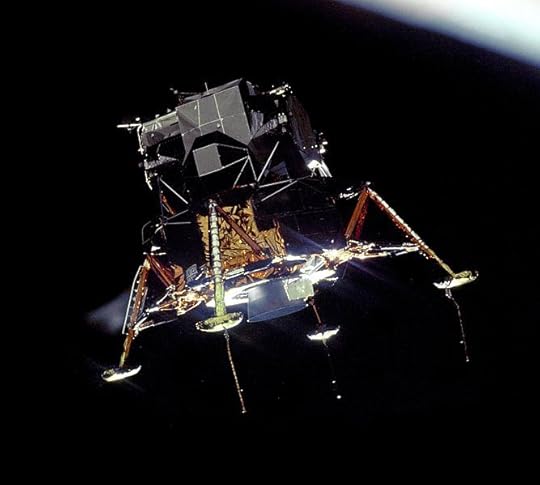
Apollo 11 Lunar Module Eagle descending to the moon, 20 July 1969, photographed from command module Columbia (NASA photo)
In the afternoon of July 20, 1969, the Space Race was coming to a head. The world’s two superpowers were in a race to retrieve samples from the surface of the moon. The USSR had effectively conceded the race to land men on the Moon to the United States following the repeated failures of the Soviet lunar rocket, the N1, earlier in the year, but there was still an opportunity to best the Americans.
The Luna 15 sample return mission, the Soviet’s last chance at getting moon rocks before the US, was orbiting the Moon, having arrived three days prior. As the Soviets were making their final preparations, the Americans were doing the same. The Apollo 11 astronauts Neil Armstrong and Buzz Aldrin were in their Lunar Excursion Module, the Eagle, preparing to leave the ship Columbia and its pilot, Michael Collins. This final confrontation and competition between the two countries was born out of the technologies and animosities that emerged from the conflagration of World War II.
Early Rockets
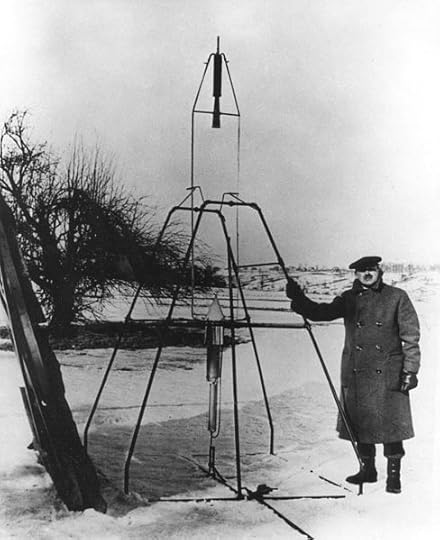
Dr. Robert H. Goddard and a liquid oxygen-gasoline rocket at Auburn, MA, 8 March 1926 (NASA photo)
The earliest development efforts on a liquid fuel rocket started with an American scientist, Robert Goddard. As early as 1917, Goddard reached out to the US military to discuss using rocketry-based weapons. One of his earliest proposals was a shoulder-fired weapon that would eventually become the bazooka. Following his first demonstration launch in 1926, he was contacted periodically by German engineers interested in his work. These questions ceased in 1939 with the outbreak of war.

Soldier holding an M1 “Bazooka,” 1943 (Library of Congress)
Once the US entered the war, Goddard was approached by the US Army, which was familiar with his work due to his acquaintance with General James Doolittle, and he was tasked with developing Rocket Assisted Take-Off technology. However, following Germany’s surrender in May of 1945, he learned how influential his work on liquid fuel rockets had been on the war, when he saw an unlaunched German V-2 rocket brought to America, which would later be joined by its mastermind, Wernher von Braun.
Wernher von Braun and the V-2 Rocket
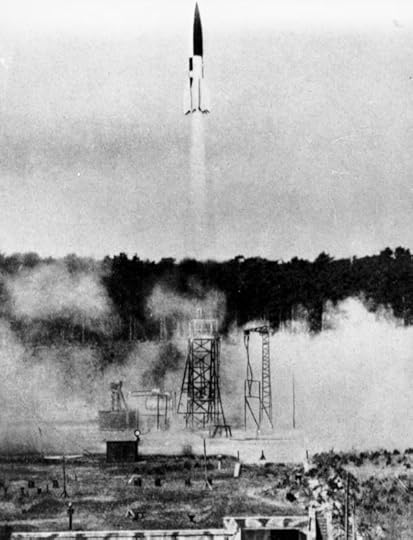
V-2 Rocket launch, Peenemünde, Germany, 21 June 1943 (German Federal Archive: Bild 141-1880)
Wernher von Braun is often quoted saying “The rocket worked perfectly except for landing on the wrong planet” upon learning the first V-2 had successfully hit London. And he was largely an idealist, having been interested in space travel since his youth, having been taught by Germany’s own rocket pioneer, Hermann Oberth.
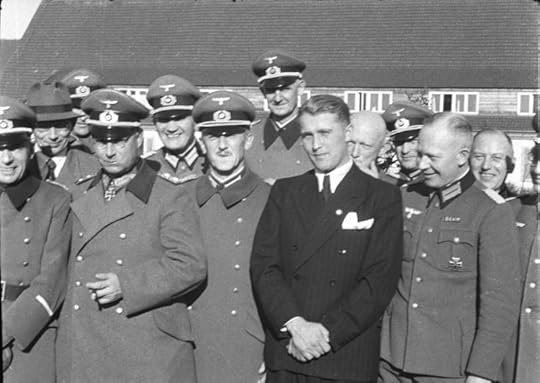
Wernher von Braun (in civilian clothes) with German officers at Peenemünde, Germany, 21 March 1941 (German Federal Archives: Bild 146-1978-Anh.024-03)
Building off Goddard’s ideas, Oberth and von Braun built a better rocket. And much like Goddard, von Braun’s country sought to use his capabilities for war, and the patriotic man complied. However, von Braun’s idealism does not excuse him from the atrocities committed by the Nazis. Von Braun was a member of the Schutzstaffel (SS), albeit for political reasons rather than ideology. The V-2s were largely built using slave labor provided from nearby concentration camps and it is estimated that 12,000 prisoners died making the rockets, more than the 9,000 Allied casualties from the rockets.
Postwar Rocket Development
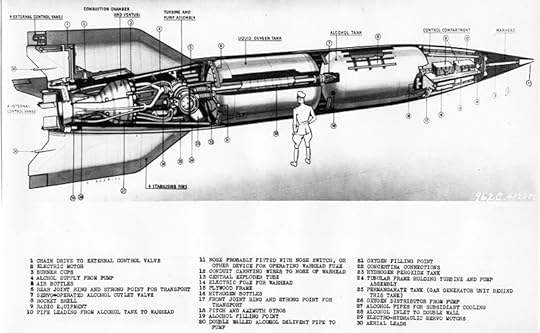
US Army V-2 cutaway drawing showing engine, fuel cells, guidance units and warhead, 1 August 1945 (US Air Force photo)
The V-2 was the starting point for both Soviet and American rocket design. Both nations actively scoured the smoldering remains of the Third Reich, searching for technological secrets, particularly related to rocketry.
Von Braun and his team chose to go to the Americans, using his SS credentials to safely journey to Austria before surrendering. With the hundreds of remaining V-2s, both the Russians and the Allies were able to reverse engineer the design, using it to kickstart their own ballistic missile programs and then immediately pointing the results at their former partners.
This technology was then used for political and scientific purposes, and the countries started putting men in space, with von Braun, now a US citizen, leading the American efforts with his rocket designs, culminating in the Saturn V rocket that sent Apollo 11 to the Moon.
Navigation and Computation
No matter how developed the rocketry was, all efforts to reach the moon would be in vain without better navigation and computation methods. The V-2 was notoriously inaccurate, even with new methods of mechanical piloting and radio guidance. During the Battle of Remagen, V-2 missiles missed a targeted bridge by up to 40 miles.

Bombe at Bletchley Park, England, 1945 (United Kingdom government photo)
However, another WWII development would allow men to traverse Deep Space: the British bombes developed by Alan Turing. As part of the British Ultra program to crack the German Enigma machine, Turing designed electromechanical machines called “bombes” to decode German military messages, which were used to great effect.

German Enigma code machine captured from U-505, Chicago Museum of Science and Industry (Photo: Sarah Sundin, September 2016).
Following the war, Turing continued developing similar machines, including the first true design of a stored-program computer. Computers were rapidly developed following the end of the war, to the point that these machines could be used to perform the staggering number of computations needed to fly to the Moon.
WWII Technology and the Moon Landings
Countless other technological developments from WWII led to that momentous day in 1969. Artificial rubber, developed due to Japanese control of rubber plantations in South Asia, led to advanced materials used to build the rockets and spacesuits.

Astronaut Buzz Aldrin’s visor and glove from the Apollo 11 mission, on display at Heinz History Center, Pittsburgh, PA, October 2018 (Photo: Sarah Sundin)
Pressurized aircraft, such as the B-29, were designed to allow bombers to reach higher altitudes, but also led to the ability to build vessels that would survive in the vast emptiness of Outer Space.

B-29 Superfortress (USAF photo)
Radar, built to detect enemy aircraft across vast distances, could now be used to track a vessel heading to the moon. All of these were crucial to the efforts to land on the Moon.
One Giant Leap…
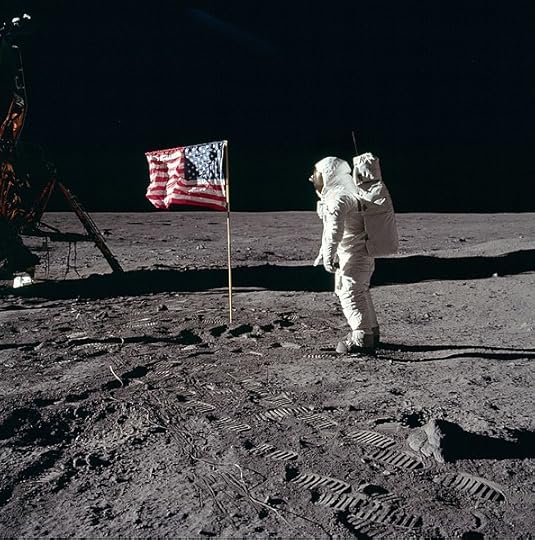
Astronaut Buzz Aldrin salutes the US flag on the moon, 20 July 1969 (NASA photo)
Ultimately, the Luna 15 mission was a failure. The Eagle successfully touched down in the evening of July 20. As the astronauts completed their mission and were preparing to return home, the Luna 15 lander crashed into a side of a lunar mountain.
But despite all the vitriol between the former allies, for a single solitary moment on July 20, 1969, the entire world watched in amazement. Temporarily oblivious to the perils of the Cold War and to the memories of the horrors of WWII, only 24 years in the past, they gazed at a grainy black-and-white image sent from the surface of the Moon. Humanity watched in wonder as the human race left its first footprint on another world, landing in a ship inscribed with the words “We came in peace for all mankind.”
Further Reading:
Recollections of Childhood by Wernher von Braun
Stephen Sundin

Stephen Sundin with the actual Apollo 11 command module Columbia, on display at Heinz History Center, Pittsburgh, PA, October 2018 (Photo: Sarah Sundin)
Stephen Sundin is a lifelong space enthusiast and history buff, receiving his first telescope from his parents at age ten. He graduated from UCLA with a degree in Mechanical Engineering; his time there included working on a NASA-funded space science mission. Stephen lives near Irvine, California and works as a satellite engineer for a startup aerospace company. He spends his time playing with his cat, Nova, and complaining about being unable to see stars at night in Southern California.
July 10, 2019
My Dearest Dietrich by Amanda Barratt
 Dietrich Bonhoeffer is well-known as a pastor who defied the Nazis and joined the resistance against Hitler. But a lesser-known aspect of this man’s life is his romance with Maria von Wedemeyer.
Dietrich Bonhoeffer is well-known as a pastor who defied the Nazis and joined the resistance against Hitler. But a lesser-known aspect of this man’s life is his romance with Maria von Wedemeyer.
In My Dearest Dietrich, Amanda Barratt brings their love to life through fiction.
At nineteen, spirited Maria von Wedemeyer is devoted to her family. While visiting her beloved grandmother, she meets Pastor Dietrich Bonhoeffer, a family friend almost two decades older than she. The two are drawn to each other and bring out the best in each other. However, Bonhoeffer works in the resistance, and the Gestapo is determined and thorough. When the worst happens, their young love is tested at the deepest level – and holds true.
This is a difficult novel, but beautiful and ultimately inspiring. Amanda Barratt brings these two historical figures to life in truly lovely prose, and the description of life in Nazi Germany is well-researched and harrowing, highlighting the heartrending choices faced by people of conscience. If you’re already familiar with Dietrich Bonhoeffer, the novel will illuminate a soft side of this greater-than-life man. And if you aren’t, you’ll want to learn more. Either way, don’t miss it. This is a powerful novel, and I highly recommend it.
July 3, 2019
Yours Truly, Thomas, by Rachel Fordham
 Penny Ercanback works in the Dead Letter Office in Washington, DC. She receives a series of letters from a Thomas that didn’t reach his Clara, and Thomas’s hurting and tender heart touches Penny. Determined to reunite the lovers, Penny begins to investigate the mysterious man.
Penny Ercanback works in the Dead Letter Office in Washington, DC. She receives a series of letters from a Thomas that didn’t reach his Clara, and Thomas’s hurting and tender heart touches Penny. Determined to reunite the lovers, Penny begins to investigate the mysterious man.
Thomas Conner is fleeing from his past in Virginia. When his Montana-bound wagon breaks down in Azure Springs, Iowa, he’s stuck for a lot longer than he likes. But the town’s friendliness is a balm to his wounds, and then he receives a letter from an anonymous woman at the Dead Letter Office who understands his pain like no other…
With an intriguing concept, Yours Truly, Thomas delivers a sweet and appealing romance with a healthy dose of humor. Rachel Fordham‘s characters grapple with grief and guilt and becoming a new person, which adds depth and heart to this warm story. Pour yourself your favorite beverage and prepare to lose yourself in this delightful story.
June 21, 2019
Today in World War II History—June 21, 1944

B-17s en route to Poltava, USSR, June 1944 (US Air Force photo)
75 Years Ago—June 21, 1944: US Eighth Air Force flies first shuttle mission to USSR; B-17 bombers leave bases in England, bomb targets in Germany, and land at Poltava. That night the Luftwaffe bombs Poltava, destroying 47 of 72 B-17s.
June 19, 2019
Ever Faithful, by Karen Barnett
 In 1933 New York City, Nate Webber has nothing going for him. A school dropout and a disappointment to his family, he voluntarily takes the rap for his little brother to keep him out of jail. But instead of sentencing Nate to jail, the judge has him join the new Civilian Conservation Corps. With dozens of other unemployed young men, Nate arrives at Yellowstone National Park to build trails and facilities. Nate’s natural leadership abilities rise to the top, but if they find out he’s unable to read, Nate will be a failure once again.
In 1933 New York City, Nate Webber has nothing going for him. A school dropout and a disappointment to his family, he voluntarily takes the rap for his little brother to keep him out of jail. But instead of sentencing Nate to jail, the judge has him join the new Civilian Conservation Corps. With dozens of other unemployed young men, Nate arrives at Yellowstone National Park to build trails and facilities. Nate’s natural leadership abilities rise to the top, but if they find out he’s unable to read, Nate will be a failure once again.
Ranger’s daughter Elsie Brookes loves her summer job working at Yellowstone, spending time with her family and friends, and saving money to go to college and become a teacher, her lifelong dream. But when her father recruits her to teach classes to the CCC men, she fears she’ll be in over her head. And why does the intriguing Nate stay away from her classes despite his obvious intelligence?
When mysterious fires strike around Yellowstone, Elsie’s old fears are awakened–especially since her cousin Graham is working at the park, the same cousin she holds responsible for the fire that killed her little sister and scarred her physically and emotionally. Nate and Elsie’s friendship – and attraction – grows, but can they solve the mystery before someone is hurt?
Ever Faithful is another gem in the Vintage National Parks series. Karen Barnett, a former ranger herself, uses her love for nature and her amazing research to bring 1933 Yellowstone to life. Nate and Elsie each bear deep scars, but they rise above them in beautiful and inspiring ways. The story is gripping, the romance is compelling, and you can practically smell the pines, the sulfur springs…and the smoke. I adored this book!
June 17, 2019
D-Day 75th Anniversary Blog Tour Winners
Thank you so much to all of you who participated in the D-Day 75th Anniversary Blog Tour! We enjoyed sharing about how we’ve been inspired by the heroes and heroines of the World War II era, and we’ve been touched by your stories and your responses. If you missed the tour, you can still read the posts. All the links are on the blog tour page.
We had 1393 entries in the main TEN-book giveaway! The winner is…
Brenda Dickson!
Thank you also for participating in each author’s individual book giveaways. And the winners are:
Whose Waves These Are by AMANDA DYKES —Jenni Jenkins
The Medallion by CATHY GOHLKE —Cathy C.
When the Heart Sings by LIZ TOLSMA —Amanda Geaney
Three-book Sunrise at Normandy series by SARAH SUNDIN –Roxanne Cruz
My Dearest Dietrich by AMANDA BARRATT –Lisa Hudson
Almost Home by VALERIE LUESSE —Karen Asfour
Memories of Glass by MELANIE DOBSON —Alison Boss
Congratulations to all the winners! Please check your email inboxes so the authors will have mailing instructions. Thank you!




